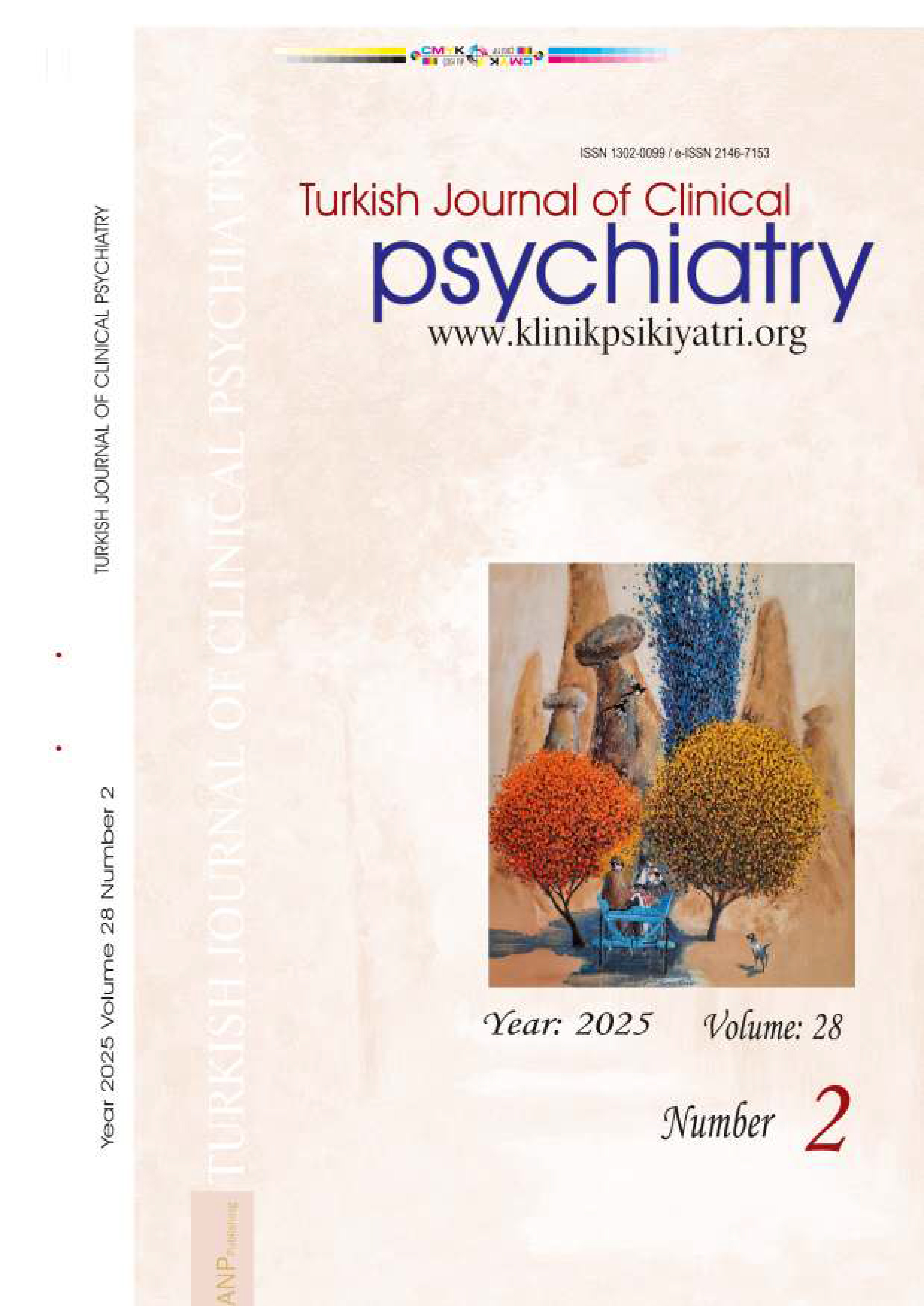





Volume: 6 Issue: 2 - 2003
| RESEARCH ARTICLE | |
| 1. | Determination of Cross-Sensitization Between Nicotine and Amphetamine in Mice Eylem ÇELİK, Tayfun Uzbay, Sirel KARAKAŞ Pages 67 - 74 The aim of the study is to investigate the effects of amphetamine on nicotine-induced locomotor sensitization in mice. Eighty adult female Swiss-Webster mice (25-35 g) were subjects. In the first section of the study, the subeffective dose of amphetamine that would be used in nicotine-amphetamine cross-sensitization study was determined. For this purpose, amphetamine (1, 2, 4, 8 and 16 mg/kg) or saline were injected to the first 6 individual groups of the mice. Then nicotine (0.5, 1 and 2 mg/kg) or saline were injected to the next 4 groups of mice (10 times at 2 day intervals). Single dose of amphetamine (4 mg/kg) was administered in the last trial (11th repetition) to these groups. The subeffective dose of amphetamine was found to be 4 mg/kg. All doses of nicotine used in the present study caused locomotor sensitization. Cross-sensitization also appeared between amphetamine and nicotine with also 1 mg/kg and 2 mg/kg nicotine dose groups. Our results suggest that similar mechanisms might play a role in the development of addiction to nicotine and amphetamine. |
| 2. | One Yfear Follow up Results of Conversion Disorder Patients with Pseudoepileptic Seizures Recep Tütüncü, M. Hakan Türkçapar Pages 76 - 79 Pseudoseizures are seen frequently in emergency wards. If they are not treated properly, recurrences are often observed. In this research, our objective is to evaluate the prognosis of conversion disorder patients with pseudoepileptic seizures after one year follow up and to assess the stability of the diagnosis. For this purpose 76 patients, who were consulted psychiatry department due to pseudoseizures and diagnosed as conversion disorder according to DSM-IV criteria, were included. Among all patients, 74 patients (%97.4) were women. 49 patients (%64.5) had no pseudoseizures.18 patients (%23.7) had seizures in a period more than one month. 9 patients (%11.8) had seizures less than one month. 36 patients (%47.4) were still taking psychiatric treatment. 15 patients (%19.7) took psychiatric treatment and 25 patients (%32.9) took treatment only in emergency wards. 10 patients (%13.1) had comorbid diagnosis. In conclusion, patients with pseudoseizures should be evaluated and followed due to psychiatric morbidity. It is important that pseudoseizures can be seen before or with an underlying psychiatric disorder. |
| 3. | Does Childhood Trauma History Effect the Psychiatric Symptoms of Conversion Disorder or Not? Hatice GÜZ, Zahide DOĞANAY, Esra ÇOLAK, Ayşin TOMAÇ, Gökhan SARISOY, Ayşen ÖZKAN Pages 80 - 85 It is known that there is a relationship between conversion disorder and childhood trauma history. The aim of this study was to determine whether the present childhood trauma history in the patients with conversion disorder related with the demographic and clinical characteristics or not. One hundred and eight patients who diagnosed as conversion disorder with DSM-IV included in this study. All patients were asked to fill a Patient Information Form, the Dissosciative Experience Scale (DES), the Symptom Check List (SCL-90-R), Suicide Ideation Scale and Colombok-Rust Sexual Satisfaction Inventory. It was determined that the mean age and the beginning age of the disease is lower and the sum of the points of GRISS, the sum of the subitems of SCL-90 such as anxiety, phobic anxiety and suicide ideation scale were higher in the 35 (32.4 %) patients who had present childhood trauma history than the patients who had not. In conclusion, presence of childhood trauma history in conversion disorder thought to be important in clinical aspects. |
| 4. | Suicide Attempt History Among Alcohol and Substance Dependents and Relationship with Clinical Symptoms E. Cüneyt Evren, Sacide USTUNSOY, Suat Can, Cengiz BAŞOĞLU, Duran Çakmak Pages 86 - 94 The aim of this study is to investigate the suicide attempt history among alcohol/substance dependents and relationship with depression, anxiety, childhood trauma, dissociative symptoms and alcohol/substance use. The study was conducted in Bakırköy Mental Health and Neurological Disease Education and Treatment Hospital, Alcohol and Substance Research and Treatment Center in İstanbul between April 2001 and June 2001. The sample consisted of 30 alcohol and 32 substance dependent inpatients according to DSM-IV. All the patients were assessed by semi-structured sociodemographic form. Childhood Trauma Questionnaire (CTQ),Dissociative Experiences Scale (DES), Hamilton Depression Rating Scale (HDRS), Hamilton Anxiety Rating Scale (HAM-A) and Michigan Alcoholism Screening Test (MAST).Suicide attempt history was found to be high among alcohol/sub- stance dependents that computed our sample. It seems that with a question that address the suicide attempt history, risk of related conditions like dissociative symptoms, depression, anxiety, childhood trauma and severity ofalcohol/substance use might be considered. Results of the study suggest that, suicide attempt history must be carefully evaluated in dependent population and special interventions must be taken with these subjects according to diagnosis and treatment. |
| 5. | Anxiety, Depression and Quality of Life in Patients with Lowback Pain and Neck Pair Kemal YAZICI, Şenel TOT, Ali BİÇER, Aylin YAZICI, Visal BUTURAK Pages 95 - 101 The aim of this study was to determine the levels of anxiety and depression, and quality of life in patients with low back pain and neck pain. Study subjects were comprised of patients with low back pain (n=50), with neck pain (n=40) and healthy controls (n = 7l). Patients and controls were administered a sociodemographic data form, Short Form-36 (SF-36) and Hospital Anxiety and Depression Scale (HAD). Pain severity was measured with Visual Analogue Scale (VAS). Duration of pain complaint were significantly longer in patients with low back pain compared to those with neck pain. Pain severity was not different between patients with low back and neck pain. We found that patients with pain complaints had poorer physical function, experienced more problems with work or other activities and had higher level of pain severity and pain associated limitations compared to controls. On the other hand, patients and controls were not different with respect to vitality, social functioning, emotional role limitation and mental health. The rate of subjects above cut-off point on HAD-Anxiety subscale was significantly higher in patients with pain compared to controls. Patients with scores above cutoff points for anxiety and depression had significantly higher quality of life scores compared to those with scores below cut-off. It is important to determine those factors that affect quality of life and to develop coping strategies for that factors. |
| REVIEW | |
| 6. | Vitamin D, Calcium, Bone Metabolism and Psychiatric Disorders Şakir Özen, Kenan HASPOLAT Pages 102 - 113 In previous years, some epidemiological studies were performed about the issue that observing depression were frequently in winter and schizophrenia mostly in the patients born in winter. During the recent 10 years, numerous experimental studies were performed with rats, and important results were determined about the effects of vitamin D on CNS beginning from the first weeks of gestation. The results revealed new questions just like "Can vitamin D3 deficiency lay the groundwork for some psychiatric disorders during the CNS developing stage and the later process?'. A lot of factors such as hypoactivity, malnutrition, less benefiting from the sunlight, hormonally changes were regarded as the causes of osteoporosis. In psychiatry, most of the causes of osteoporosis mentioned here were seen in the long lasting diseases such as dementia, depression, schizophrenia. Reason-result relations of psychiatric disorders and vitamin D, bone, calcium metabolism are important, but in reality, it is less emphasized subject in the clinical settings. In this study, we reviewed the effects of vitamin D, bone, calcium metabolism changes on the possible etiologic causes and symptomatic stages of the psychiatric diseases with the guidance of the literature. To improve the quality of life of patients and to provide the longer duration of the well-being, it should be also emphasized on these topics in the clinical practices. |
| CASE REPORT | |
| 7. | Psychiatric Disorders due to Hemochromatosis: A Case Report with Psychotic Disorder and Review of the Literature Sermin KESEBIR, Erhan BAYRAKTAR Pages 114 - 118 Hemochromatosis is a rare disorder characterized by iron deposition in various tissues and organs, leading to fibrosis and functional organ failure. A 38 year-old man with a psychotic feature is presented. In his clinical examination social isolation, occupational and social withdrawalI were asssesed. He was infertile as a result of hipogonadotropic hypogonadism and had diabetes mellitus. Serum ferritin level was raised to 502 mikrogram/l. Genotyping confirmed HFE gene on chromosome 6 was positive. There were iron deposits both in the basal ganglia which were demonstrated by magnetic resonance imaging and in the liver. The iron accumulation due to hemochromatosis in central nerve system is considered to be the etiology of psychosis. In this review our hemochromatosis case in considered with the cases that are reported in the literature and the role of iron accumulation in the etiology of psychosis evaluated. |
| 8. | Clozapine-Induced Seizure and its Treatment by Gabapentine: Case Report İbrahim Eren Pages 119 - 122 Clozapine is a highly potent neuroleptic drug that, in contrast to other neuroleptic agents, does not induce extrapyramidai side effects. However, it may induce irreversible agranulocytosis, EEG changes, myoclonus, and epileptic seizures. Clozapine is reported to cause seizure and EEG changes with high ratio. Several antiepileptics, including phenytoin, carbamazepine, and valproic acid, have been found to be effective in the treatment of these seizures, but certain side effects and pharmacokinetic interactions may limit their prescription in combination with clozapine. Valproate is recommended as the standard therapy for the treatment of clozapine-induced seizures, however valproate can induce significant side effects when combined with clozapine and can modify the metabolism of clozapine. Gabapentine is a relatively new antiepileptic drug with a benign side effect profile and a lack of significant pharmacokinetic interactions. Therefore gabapentine may be an alternative to valproate in treatment of clozapine-induced seizures. Our report is on a schizophrenic patient who had a generalized tonic-clonic seizure with clozapine therapy who was treated successfully with gabapentine. |










